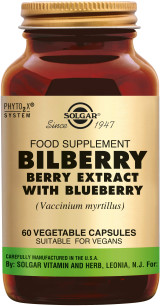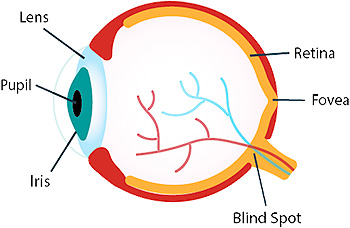Powerful Formulas for the Eye

- Complete formula for the eyes
- With carotenoids, flavonoids, rutin, minerals, taurine and L-cysteine

- Formula for the eyes
- Contains bilberry and pycnogenol

- Formula for the eyes
- Contains vitamins, minerals and botanicals (rich in antioxidants)

- Formula for the eyes
- Contains vitamins, minerals, amino acids and herbs

- Formula for the eyes
- Contains B vitamins and bilberry
6 Best Supplements for the Eyes








Buy the best supplements for the eyes here. Or read more below.

We have six formula products and six individual supplements that help maintain normal vision.
A well-known herb for the eyes is Eyebright. We don't have a separate supplement of that but it is part of Solgar Bilberry Ginkgo Eyebright Complex.
Our eyes: the most important sense-organ
The eyes are our most important sense organ. In the eyes, signals from the environment are received and transmitted to the brain. As much as about a third of the cerebral cortex (cortex cerebri, the outer layer of the cerebellum) is involved in processing light signals. This is not surprising since it is also a complex sensory organ.
Photo camera
In essence, you can compare the eye to a camera. Light enters through the cornea and lens, passes through the eyeball and is then projected onto the light-sensitive photoreceptor cells on the retina (image sensor). The retina lies against the back of the eye and can actually be considered an extension of the brain.
In the retina (retina) are light-sensitive cells in the form of cones and rods. The cones are most commonly found in the yellow spot (macula), which lies in the center of the retina. Cones are able to perceive color and fine details. Rods cannot perceive color but are useful in dim situations.
Cone cones for colors
Humans have 3 types of cones; red, green and blue. A person who is color blind is often missing one type of cone. Birds, fish and reptiles are better provided for, with 4 color receptors.
The information from these light-sensitive cells is carried to the brain via nerve fibers. Halfway across, these nerve fibers cross so that the right hemisphere receives information about the left side of visual perception, and the left hemisphere receives information about the right side of visual perception.
Tears
Tears are inseparable from our eyes and have several functions:
Basal tears
Trans allow our eyelids to glide smoothly over the eyes, and in addition they also wash away dust and small blemishes.
Reflex tears
Reflex tears arise when the eye becomes irritated, due to cold wind or certain substances (cutting onion, for example). The tears put a film of water on the cornea to protect it from cold or corrosive substances, for example.
Emotional tears
Unique we are as humans at having "emotional tears". Tears running down your cheeks are usually the result of an emotion: the tear pores cannot drain the moisture fast enough so that flooding follows.
The structure of the eye
The visible part of the eye consists of an eyeball. This consists of 3 layers that envelop the internal structures.
From the outside to the inside, these are the hard skirt of the eye (sclera), the choroid (choroidea) and the retina (retina).

The main function of the hard eye skirt is to maintain the round eyeball shape. The eye skirt consists largely of collagen fibers.
The inside of the eyeball is lined by the choroid. It is a very well circulated membrane and provides the blood supply to the eye.
The retina is actually a kind of extension of the brain and very sensitive to light. It is made up of cells called photoreceptors.
Internal construction of the eyeball
The cornea is located at the front of the eye; this is where the light enters. Behind the cornea lies the iris with pupil and behind it lies the eye lens. The eye lens can change strength (accommodate).
The inner eye consists largely of a jelly-like substance and is also called the vitreous body.
The eyeball has 2 eye chambers, an anterior and posterior, these 2 are connected through the pupil and are filled with chamber water. The chamber water contains nutrition for the lens and cornea. This is important because these are not perfused.



